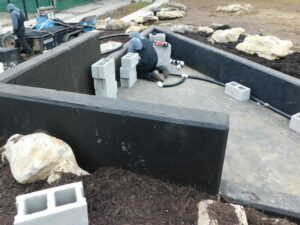
A green space amid the concrete sidewalks and streets of downtown Fort Scott will soon be ready for public enjoyment.
Work on the Unsung Heroes Park, just south of the Lowell Milken Center at 1 S. Main, is progressing.
“It would be nice to have it done by the all-school reunion (in late June),” Beth Nuss, one of the organizers of the park told the Downtown Meet and Greet on Jan. 28. “But you know how that goes with weather.”
On January 28, some employees of DreamScape Innovations, Inc., of Mound City, were installing plumbing pipes, planting trees and laying down mulch.
Employee Justin Robertson said weather permitting, that the water feature project will be completed in a few weeks.
R2 Construction did the excavation and concrete work on the site.
Future Work
A stage area is being planned for the wall of the old Kress building which is on the south side of the park.
The Rotary Club is donating benches and trash receptacles for the park.
A bench is also being donated by Niece Of Kansas, Inc. in honor of employee Pat Flanagan who died in September 2019.
There will be a small fenced area for dogs in the park.
“The area for dogs will try to accommodate pets of people living downtown,” she said in a prior interview.
History
The area has been vacant since 2005 when the building sitting on it, burned down.
The idea of green space in downtown Fort Scott began in 2017.
The planning group is currently comprised of Elaine Buerge, Bernita Hill, Beth Nuss, and Carolyn Sinn.
After the original research and planning took place, bids were let.
“The bids were not financially feasible,” Nuss said in a previous interview. “So we needed to revisit the plan.”
“All the money we had was donated,” she said.
Then the Timken Company stepped in with a grant of $25,000, “which got us to the top,” Nuss said.
Since it is a privately funded project, organizations and individuals who would like to contribute may contact group members, said committee member Bernita Hill.
.